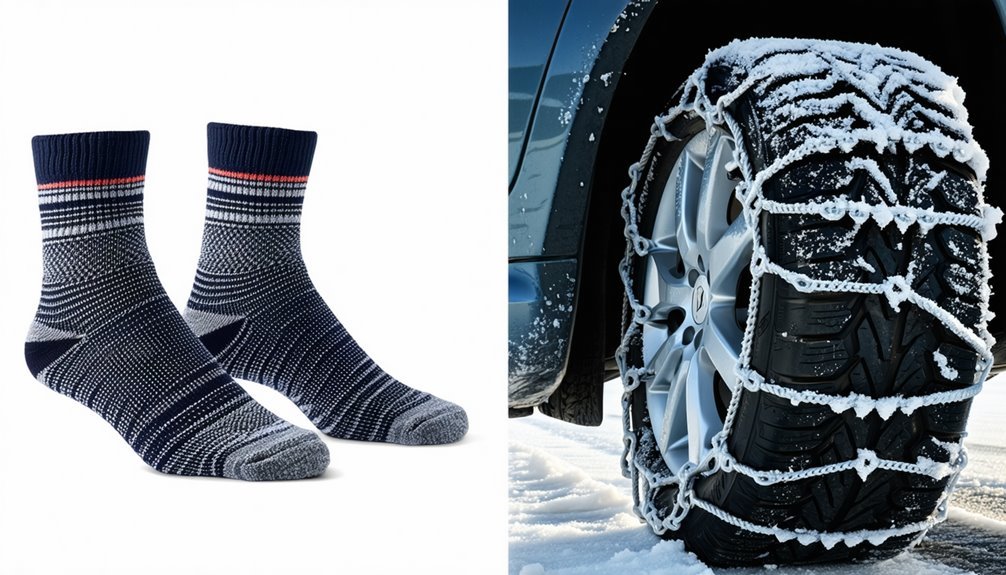Snow Socks Vs Chains Reddit
When evaluating snow socks vs chains for winter driving, consider installation ease, performance, and environmental fit. Snow socks excel in urban areas with light snow, providing smooth ride, easy installation, and minimal legal constraints. Chains thrive in deep snow and rugged terrains, offering superior traction but requiring intricate installation and substantial legal checks. Costs initially favor snow socks, while chains prove cost-effective long-term. Discover more insights and scenarios for making the best choice.
Understanding Snow Socks and Tire Chains

When traversing icy or snowy roads, understanding the function and advantages of snow socks and tire chains is vital for safety and performance. Snow socks, made from high-strength fabric, offer excellent grip on snow and ice. They're easy to install and remove, making them a convenient choice for emergency situations. Their lightweight nature means they won't add significant weight to your vehicle, reducing strain on your tires.
Tire chains, on the other hand, provide unparalleled traction, especially in extreme conditions. Known for their chain durability, they're built to withstand harsh climates and rugged terrains. While heavier and more complex to install, their robustness guarantees long-lasting performance. For maximum safety, selecting the appropriate solution based on your driving conditions is essential.
Key Differences Between Snow Socks and Chains
Although both snow socks and tire chains serve the purpose of enhancing traction on icy or snowy roads, they differ markedly in their design and application. Snow socks, made from high-strength fabric, offer a lightweight and easy-to-install alternative to traditional chains. One of the snow socks benefits is their quieter operation and minimal impact on vehicle suspension and tires. They're particularly effective in light to moderate snow conditions. On the other hand, tire chains, while providing superior grip in severe conditions, present drawbacks such as increased noise and potential damage to tires or roads. Additionally, chains can be cumbersome to fit, especially in freezing temperatures. Considering safety, snow socks might be preferable for urban areas, while chains excel in more extreme environments.
User Experiences From Reddit: Snow Socks
On Reddit, many users highlight the ease of installation as a major advantage of snow socks over chains, noting that you can fit them quickly without the hassle of complex tools. While some users report satisfactory performance in moderate snow conditions, others suggest that snow socks may struggle in deeper snow or icy terrains. It's important to take into account these varied experiences when deciding if snow socks meet your specific winter driving needs.
Ease of Installation
Snow socks have gained popularity as a convenient alternative to traditional tire chains, especially regarding ease of installation. Many users on Reddit highlight how quickly and effortlessly snow socks can be installed compared to cumbersome chains. Installation tips frequently emphasize the importance of practicing before you're faced with inclement weather. Users often suggest laying the sock flat on the ground and aligning it with the tire for a smoother fit. Feedback indicates that even those with minimal mechanical skills find snow socks manageable, reducing time spent exposed to cold conditions. Unlike chains, which require tensioners and adjustments, snow socks slip on with minimal hassle, providing a safer, faster solution for those prioritizing safety and efficiency in winter driving scenarios.
Performance in Snow
When it comes to evaluating the performance of snow socks in snowy conditions, user experiences on Reddit provide valuable insights. Many drivers find snow socks advantageous due to their ability to enhance traction on icy and powdery surfaces. The fabric material of snow socks grips the road effectively, offering a smoother ride compared to the jarring experience often associated with tire chains. While tire chains can sometimes damage roads or vehicle components, snow socks are gentle on both, minimizing the risk of damage.
However, it's essential to recognize the limitations. Snow socks may wear faster under extreme conditions, and aren't as effective in deep snow as tire chains. Users recommend evaluating your specific driving environment to determine if the snow socks advantages outweigh the tire chains disadvantages.
User Experiences From Reddit: Tire Chains
When considering tire chains for deep snow conditions, you'll find Reddit users often highlight their unmatched traction capabilities. However, they also point out that installation can be challenging, especially in freezing temperatures or when you're in a rush. Industry insights suggest that practice and familiarity with your specific chain model can mitigate these installation hurdles.
Chains for Deep Snow
Although snow socks have gained popularity for their ease of use, chains remain the go-to option for tackling deep snow, according to user experiences on Reddit's "Tire Chains" community. When facing extreme winter conditions, deep snow safety becomes essential. Chains provide unmatched traction enhancements, ensuring your vehicle remains stable and controllable. Reddit users often highlight their ability to dig into snow and ice, offering superior grip compared to other traction devices. This is particularly significant when dealing with steep inclines or icy roads. Chains are engineered for durability and reliability, making them ideal for prolonged use in harsh environments. While not the easiest to install, their performance in deep snow is widely acknowledged, affirming their status as a trusted choice for winter driving safety.
Chains Installation Challenges
Despite their effectiveness, installing tire chains presents several challenges that are frequently discussed in the Reddit "Tire Chains" community. It's vital to address these issues to guarantee safety and peak performance. Here are some key points:
- Fitment Issues: Incorrect sizing can lead to chains slipping off or damaging tires.
- Complex Installation: Many users find the initial setup intimidating without proper installation tips.
- Time-Consuming: Chains require time and patience, especially in harsh weather conditions.
- Chain Maintenance: Regular inspection and maintenance are fundamental to prevent rust and wear.
- Noise and Vibration: Chains can increase road noise and vibration if not properly adjusted.
Performance in Different Weather Conditions

In evaluating the performance of snow socks versus chains across various weather conditions, it is essential to take into account factors like traction, durability, and ease of use. When considering weather adaptability, snow socks excel in light snow and icy conditions, providing a reliable grip without damaging the road surface. Their fabric construction allows for flexibility, enhancing performance metrics in moderate climates. However, they may underperform in heavy snow or deep slush.
On the other hand, chains offer superior traction in severe weather, digging into packed snow and ice for enhanced stability. Their durability is unmatched, making them a robust choice for extreme conditions. However, chains can be noisy and may impact vehicle handling on cleared roads. Prioritize safety by selecting the option best suited for your typical weather conditions.
Installation and Removal: Comparing Ease of Use
Understanding the performance capabilities of snow socks and chains in different weather conditions sets the stage for examining their installation and removal processes. User feedback often highlights the ease of using snow socks compared to chains. Installation tips suggest snow socks are more straightforward, involving slipping them over tires without needing tools. Chains, however, require specific tensioning and can be cumbersome, especially in harsh conditions.
Here's what you should consider:
- Snow socks: Quick slip-on design; no tools needed.
- Chains: Require proper tensioning; can be complex.
- User feedback: Generally favors snow socks for ease.
- Safety: Chains offer a secure fit but demand correct installation.
- Time: Snow socks save time in adverse weather.
Prioritizing ease of use can enhance your safety and efficiency on icy roads.
Impact on Vehicle Performance and Handling
When considering snow socks versus chains, you'll want to focus on how each affects traction, steering control, and overall vehicle dynamics. Snow socks are generally easier to install, offering a smoother ride with less impact on steering, but they may not provide the same level of traction as chains in severe conditions. Chains, while more cumbersome to fit, typically deliver superior traction, though they can affect steering precision and increase tire wear.
Traction Differences Explained
While traversing winter roads, the choice between snow socks and chains can profoundly affect your vehicle's traction, performance, and handling. Both options offer unique benefits, tailored to different driving conditions. Snow socks provide advantages like increased grip on icy surfaces, ensuring a smoother ride without damaging the road. They're lightweight and won't considerably affect fuel efficiency. However, tire chains are known for their durability, offering superior traction in deep snow and rugged terrain.
Here's a quick comparison:
- Snow Socks Advantages: Lightweight, easy to store.
- Tire Chains Durability: Long-lasting, reliable in harsh conditions.
- Surface Contact: Snow socks excel on ice; chains perform well in snow.
- Performance Impact: Chains can affect ride smoothness.
- Handling: Snow socks provide a quieter, less bumpy experience.
Safety depends on your choice.
Installation and Removal Ease
Choosing between snow socks and chains involves considering their installation and removal processes, which directly affect vehicle performance and handling. Snow socks often boast simpler installation techniques, allowing you to quickly slip them over your tires without requiring much physical exertion. This ease can enhance vehicle performance by minimizing downtime and ensuring ideal traction faster. Chains, on the other hand, demand more effort and precision during installation, which can be time-consuming and might lead to improper fit if not done correctly.
When it comes to removal tips, snow socks easily slide off, reducing the risk of damage to your vehicle. Chains, although effective, require careful unfastening to avoid harming your tires or wheel components. Prioritize safety by choosing a solution that aligns with your capabilities and needs.
Impact on Steering Control
Snow socks and chains each influence steering control in distinct ways, impacting overall vehicle performance and handling. When considering steering responsiveness and handling precision, choosing between snow socks and chains can alter your driving experience markedly. Snow socks offer smoother steering, enhancing the vehicle's response to inputs. They provide:
- Increased steering responsiveness due to their fabric material, which grips snow efficiently.
- Enhanced handling precision in mild conditions, ensuring a safer drive.
- Reduced noise and vibration, contributing to comfortable steering feedback.
- Limited traction in severe icy conditions, potentially compromising safety.
- Quick adaptability for sudden weather changes without affecting steering.
Conversely, chains offer robust traction but can reduce steering precision. Their metal components grip ice effectively, but may introduce vibration and noise, affecting steering control.
Legal Considerations and Regional Restrictions
Understanding the legal considerations and regional restrictions regarding snow socks and chains is essential for guaranteeing compliance and safety during winter travel. Legal requirements vary, so familiarize yourself with regional laws before hitting the road. Some regions mandate snow chains, especially in mountainous or high-snowfall areas, while others allow snow socks as an alternative, provided they meet certain criteria.
| Region | Legal Requirement |
|---|---|
| California | Chains mandatory in some areas |
| Colorado | Chains or snow socks allowed |
| Washington | Chains required in certain conditions |
| Oregon | Chains required in snow zones |
Ignoring these legal stipulations can result in fines and unsafe driving conditions. Always check local advisories and road signs to determine the required traction devices. Compliance not only guarantees legal adherence but prioritizes your safety and that of other road users.
Cost Analysis: Snow Socks Vs Chains
When evaluating the cost of snow socks versus chains, it's important to contemplate factors like initial purchase price, durability, and maintenance. With regard to cost comparison, snow socks generally have a lower initial price, making them attractive for budget considerations. However, their lifespan may be shorter compared to chains, which can withstand rougher conditions. Analyzing your needs and driving conditions helps determine which option will provide the best value for safety.
- Initial Purchase Price: Snow socks are usually cheaper.
- Durability: Chains tend to last longer in severe conditions.
- Maintenance: Chains may require more upkeep.
- Replacement Frequency: Snow socks might need more frequent replacement.
- Long-term Investment: Chains could be more cost-effective over time if used regularly.
These insights should guide your decision based on cost-effectiveness and safety.
Recommendations for Various Driving Scenarios

Whether you're traversing urban streets or tackling rugged mountain roads, selecting the right traction device is essential for safe winter driving. For city driving, snow sock benefits include ease of installation, lightweight design, and suitability for vehicles with limited clearance. They're ideal when you anticipate only occasional snow or icy conditions and need a quick, convenient solution.
In contrast, chain effectiveness shines on mountainous terrain or regions with heavy snowfall. Chains provide superior grip on thick ice and deep snow, making them indispensable for challenging environments. However, they require more effort to install and may not be suitable for all vehicles. Always consider your typical driving conditions and vehicle specifications when choosing between snow socks and chains to guarantee maximum safety and performance.
Frequently Asked Questions
Can Snow Socks Damage My Vehicle's Tires?
Did you know that improper use of snow socks can increase tire wear by 20%? While they offer traction benefits, incorrect installation or usage could lead to traction issues, potentially compromising your vehicle's safety and tire longevity.
Are Snow Socks Reusable in Multiple Snow Seasons?
Snow socks are reusable if you maintain them properly. Regular inspections for wear and tear are essential. Their seasonal performance depends on usage and care, ensuring safety across multiple snow seasons with proper snow sock maintenance and storage.
Do Snow Socks Fit All Tire Sizes?
Think of snow socks as a snug sweater for your tires. They don't fit all tire sizes. Snow sock compatibility depends on tire size variations, so checking your tire's dimensions is essential for ensuring effective grip and safety.
What Is the Lifespan of Tire Chains?
You're likely wondering how long tire chains last. With proper tire chain maintenance, they can endure several winters. Regular inspection guarantees winter driving safety, preventing accidents and costly repairs. Always prioritize quality and fit for peak performance.
Can Snow Socks Be Used on Icy Roads?
Snow socks can be your icy road superheroes, but don't expect miracles. Their performance on icy roads offers decent traction, enhancing safety, though not as robust as chains. Always consider your specific conditions and driving needs for ideal safety.







